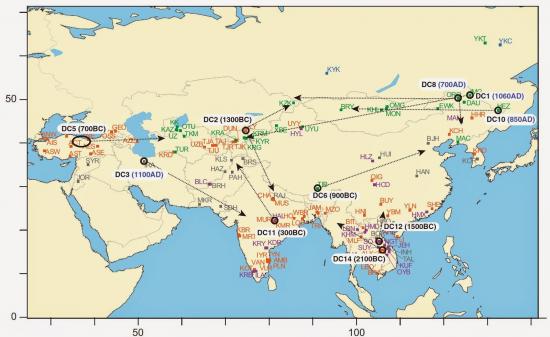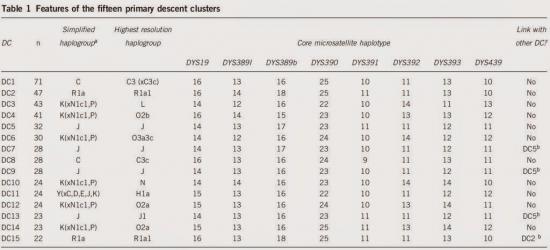Source -http://dienekes.blogspot.fr/

This is a very exciting paper. Most of these lineages are so young that there are good chances that their founders were figures from history or mythology.
The most interesting one is DC2 which was also found in south Siberian Kurgans, belongs to haplogroup R1a1 and is given an age of 3,284 years by the authors (with some almost impossibly wide confidence intervals). Based on its distribution, and if a Bronze Age date is right, it is difficult to see in it anything other than a patrilineage that was present in Proto-Indo-Iranians.

European Journal of Human Genetics advance online publication 14 January 2015; doi: 10.1038/ejhg.2014.285
Y-chromosome descent clusters and male differential reproductive success: young lineage expansions dominate Asian pastoral nomadic populations
Patricia Balaresque et al.
High-frequency microsatellite haplotypes of the male-specific Y-chromosome can signal past episodes of high reproductive success of particular men and their patrilineal descendants. Previously, two examples of such successful Y-lineages have been described in Asia, both associated with Altaic-speaking pastoral nomadic societies, and putatively linked to dynasties descending, respectively, from Genghis Khan and Giocangga. Here we surveyed a total of 5321 Y-chromosomes from 127 Asian populations, including novel Y-SNP and microsatellite data on 461 Central Asian males, to ask whether additional lineage expansions could be identified. Based on the most frequent eight-microsatellite haplotypes, we objectively defined 11 descent clusters (DCs), each within a specific haplogroup, that represent likely past instances of high male reproductive success, including the two previously identified cases. Analysis of the geographical patterns and ages of these DCs and their associated cultural characteristics showed that the most successful lineages are found both among sedentary agriculturalists and pastoral nomads, and expanded between 2100 BCE and 1100 CE. However, those with recent origins in the historical period are almost exclusively found in Altaic-speaking pastoral nomadic populations, which may reflect a shift in political organisation in pastoralist economies and a greater ease of transmission of Y-chromosomes through time and space facilitated by the use of horses.